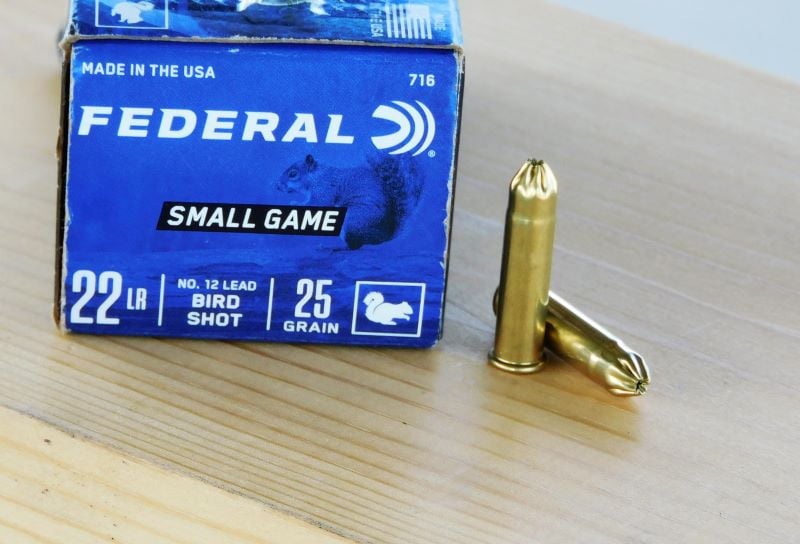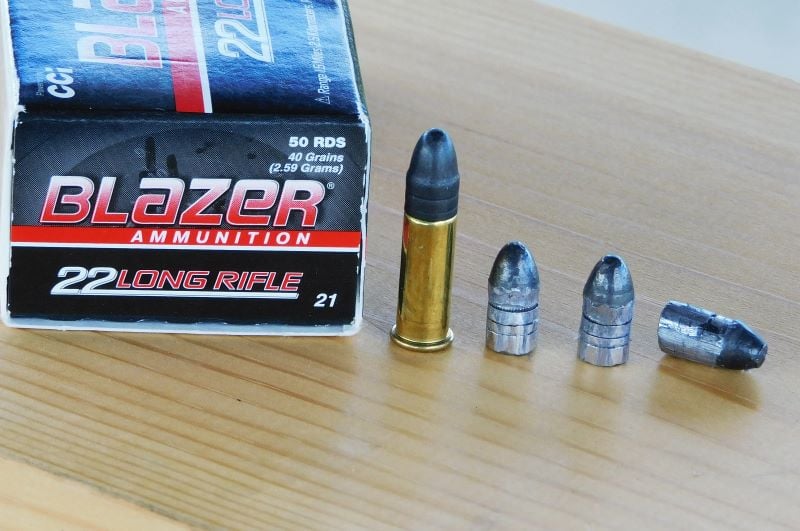In a world preoccupied with concealed carry and even wilderness defense, it is hard to justify pistols chambered in the tiny .22 LR cartridge. But as an all-around tool, especially in the great outdoors, there may not be anything better. Pistols chambered in the affordable .22 LR rimfire cartridge are a popular choice due to their compactness and inherent accuracy. This allows them to be deployed for the trap line, small game hunting, dispatching wounded animals, and even personal defense. While the .22 is light in the power department, it will generally get the job done. But some ammunition is more effective for a given task, while others are less so. Here are five common .22 Long Rifle trail loads categorized and compared.

No. 12 Shot
Until recently, hunters in the state where I reside were only allowed to carry .22 LR pistols as sidearms. It was also regulated that these pistols could only be loaded with birdshot, also known as “rat shot.” Rat shot shells consist of a brass case with several small pellets in place of a single projectile. These pellets lack the mass to penetrate deeply or travel long distances. Rat shot is intended to kill small animals in situations where using conventional ammunition is disadvantageous. You can dispatch rats and birds without potentially blowing a hole through wherever the varmint is hiding. The spread of rat shot also makes it ideal for killing snakes at close range.

CCI offers a No. 12 shot load that consists of a plastic cup filled with shot in the place of a bullet. Federal offers a traditional shotshell load with a longer brass case that is crimped over the enclosed shot load. Both loads have a nominal 25-grain weight to the total of the pellets.
In my experience, .22 rat shot tends to pattern fairly tight using shorter-barreled handguns. But beyond about fifteen feet, few pellets hit the intended target with any authority. To test the effectiveness of Federal No. 12 load, I shot a bare block of 10% Clear Ballistics gelatin from ten feet away. The pistol I used is a Ruger Wrangler revolver with a 3.75-inch barrel.

Although I fired at what I would consider to be the maximum effective range for No. 12 shot, the gelatin block was peppered with numerous pellets. A few pellets made it two inches into the block, but the vast majority stopped between 1-1.5 inches. The damage to our muscle tissue simulant is sufficient for what rat shot is intended for but the tiny pellets would do little against more hardened critters.
40-Grain High-Velocity Solids
Most .22 Long Rifle rounds can be broken down into two categories: 40-grain solids or lighter-grain hollow points. Most of these will be advertised as high-velocity rounds reaching speeds greater than 1,250 feet per second.
Common 40-grain solid loads include the CCI Mini Mag, Remington Golden Bullet, and Federal Automatch. They all use a lead round-nosed bullet, but some brands copper-coat their projectiles. These solid loads have the advantage of being nonexpanding and, in theory, will give more penetration. Solid point bullets also have the potential advantage of doing less meat and hide damage compared to hollow point bullets.

The ammunition I selected to represent the class of 40-grain solid ammunition is CCI Blazer ammunition. It is the same ammunition as the CCI Mini-Mag 40-grain solid but without a copper wash on the projectile. It runs at an advertised velocity of 1,260 feet per second. That velocity is approximate to what you can expect out of a rifle-length barrel. I fired a volley of five rounds over my Caldwell Chronograph from 10 feet away using the Ruger Wrangler. The average velocity of the Blazer load came in at 1,064 feet per second.

At a distance of 15 feet, I fired three rounds of CCI Blazer into a pair of gelatin blocks, but each round tumbled out and escaped the block. I fired three more rounds and got three solid hits. These bullets also tumbled, leaving impressive inch-wide stretch cavities in the first block before coming to rest nose-first at about 10.5 inches.
Although there is a loss of velocity when moving from a rifle to a handgun, the CCI Blazer did a surprising amount of damage and gave moderate penetration. The first three inches of the block bore little damage, so I surmised that this class of projectile would do little meat or hide damage on small critters but might do too much if the animal is any larger. On the other hand, this surprising amount of damage and reasonable penetration can be a great asset when used on smaller predators like coyotes.
High-Velocity Hollow Points
.22 Long Rifle hollow points can be a mixed bag depending on the gun of your choice. All available loads use a 32-38-grain lead bullet. That lighter bullet takes up less room in the case, which makes room for more powder. Like other .22 loads, these projectiles are meant to open up when fired out of a rifle-length barrel. That is great for varmint work but might cause too much meat damage. When fired out of a longer-barreled pistol, hollow point loads will give moderate expansion and a bit more penetration compared to a rifle. Hollow point expansion becomes nonexistent out of short-barreled handguns. But even without expansion, the higher velocity of these lighter hollow point bullets can still smack targets with more authority over slower-speed solid loads.

Two common .22 LR hollow point loads are the CCI Stinger and the CCI Mini Mag. These are high-velocity hollow points that use 32-grain and 36-grain bullets, respectively. The CCI Stinger is classified as a hypervelocity round with an advertised velocity of 1,640 feet per second. The Mini Mag is more typical for .22 LR hollow points since its heavier 36-grain hollow point is running at about 1,260 feet per second. When fired from the Ruger Wrangler, the Stinger had an average velocity of 1,196 feet per second. The Mini Mag clocked in at 1,108 fps.

I fired three Mini Mag rounds followed by three Stingers from a distance. One Stinger struck the block close to the edge and was lost. One Stinger round failed to expand and tumbled backward, stopping at 8.5 inches. The other expanded and fell shorter at eight inches. The Mini Mags resisted tumbling and traversed the first block doing little damage. The three projectiles stopped at the 11.25-, 11.5-, and 13-inch mark.

Out of a moderate-length pistol barrel, the CCI Stinger still has varmint potential. It holds onto expansion potential and makes marginally bigger holes on target. I was surprised at how it out-penetrated lead rounds like the CCI Blazer without the tumbling damage. Although our test medium does not take heavy bone into account, the Mini Mag load might still be the ticket for a deep penetrating load that can also get the job done on small game targets without much damage to what goes into the pot.
The Bottom Line
There are more good .22 LR loads out there than bad, but each will perform differently on target. This is especially important to take into consideration when you step down from your hunting rifle to a sidearm. You will lose velocity and power and, see positives and negatives with different loads. Match the load for the tasks you expect your sidearm to do. But perhaps most important is matching the ammo to the handgun. None of the results demonstrated here matter if the round is not reliable or accurate enough to be relied upon.

